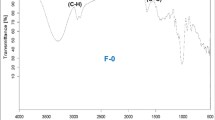Abstract
Most of the starch in starch-polyethylene-co-acrylic acid (EAA)-polyethylene (PE) composites prepared by injection molding was not accessible to starch-hydrolyzing enzymes. Even when these composites were treated with enzyme in the presence of Triton X-100 for 96 h, little starch hydrolysis was observed. However, when the starch-plastic material was pulverized, both the extent and the rate of starch hydrolysis increased dramatically, with about 70% hydrolysis of the starch within 18 h. Reactions carried out for up to 96 h showed that, while the enzyme was active, the reaction reached a plateau, achieving a total of 80% starch hydrolysis. Fourier transform infrared (FTIR) spectroscopy revealed that only starch, and not EAA or PE, was affected by enzyme in pulverized samples. Results indicated that while 80% of the starch in these composites was transiently inaccessible, perhaps due to EAA and PE forming an impermeable barrier to the enzyme, the other 20% remained inaccessible to enzymes. Also, the rate of starch digestion as determined by solubilized reducing sugar correlated with the particle size of the pulverized material, suggesting that a large available surface area is critical for rapid starch degradation in such composites.
Similar content being viewed by others
References
G. F. Fanta, C. L. Swanson, and W. M. Doane (1992)Carbohydr. Polym. 17 51–58.
F. H. Otey, R. P. Westhoff, and C. R. Russell (1977)Ind. Eng. Chem. Prod. Res. Dev. 16 305–308.
F. H. Otey and R. P. Westhoff (1982) U.S. Patent 4,337,181.
C. L. Swanson, R. L. Shogren, G. F. Fanta, and S. H. Imam (1993)J. Environ. Polym. Degrad. 1 155–165.
G. F. Fanta, C. L. Swanson, and R. L. Shogren (1992)J. Appl. Polym. Sci. 44 2037–2042.
J. M. Gould, S. H. Gordon, L. B. Dexter, and C. L. Swanson (1990) in J. E. Glass and G. Swift (Eds.),Agricultural and Synthetic Polymers: Biodegradability and Utilization, ACS Symposium Series No. 433, American Chemical Society, Washington, DC, pp. 65–75.
B. K. Jasberg, C. L. Swanson, R. L. Shogren, and W. M. Doane (1992)J. Polym. Mat. 9 163–170.
U.S. Congress, Office of Technology Assessment (1993)Biopolymer: Making Materials Nature's Way, U.S. Government Printing Office, Washington, DC.
S. H. Imam, J. M. Gould, S. H. Gorden, M. P. Kinney, A. M. Ramsey, and T. R. Tosteson (1992)Curr. Microbiol. 25 1–8.
R. L. Shogren, A. R. Thompson, F. C. Felker, R. E. Harry-Ókuru, S. H. Gordon, R. V. Greene, and J. M. Gould (1991).J. Appl. Polym. Sci. 44 1971–1978.
R. L. Shogren, A. R. Thompson, R. V. Greene, S. H. Gordon, and G. L. Cote (1991)J. Appl. Polym. Sci. 47 2279–2286.
S. H. Imam, S. H. Gordon, A. R. Thompson, R. E. Harry-Ókuru, and R. V. Greene (1993)Biotechnol. Techniq. 7 791–794.
W. S. Hoffman (1937)J. Biol. Chem. 120 51–55.
S. H. Imam, A. Burgess-Cassler, G. L. Cote, S. H. Gordon, and F. L. Baker (1991)Curr. Microbiol. 22 365–370.
S. H. Imam and J. M. Gould (1990)Appl. Environ. Microbiol. 56 872–876.
S. H. Imam, R. V. Greene, and H. L. Griffin (1990)Appl. Environm. Microbiol. 56 1317–1322.
S. H. Imam, R. V. Greene, and H. L. Griffin (1993)Appl. Environ. Microbiol. 59 1259–1263.
S. H. Imam and R. E. Harry-Ókuru (1991)Appl. Environ. Microbiol. 57 1128–1133.
S. H. Imam and W. J. Snell (1987)Appl. Environ. Microbiol. 53 1701–1704.
S. H. Imam and W. J. Snell (1988)J. Cell Biol. 106 2211–2221.
A. Burgess-Cassler, S. H. Imam, and J. M. Gould (1991)Appl. Environ. Microbiol. 57 612–614.
Amylase Research Society of Japan (1988)Handbook of Amylases and Related Enzymes, Pergamon Press, New York.
J. F. Roybt (1984) in Whistler, BeMiller, and Paschall (Eds.),Starch: Chemistry and Technology, Academic Press, New York, pp. 87–123.
J. S. Peanasky, J. M. Long, and R. P. Wool (1991)J. Polym. Sci. B Polym. Phys. Ed. 29 565–579.
Author information
Authors and Affiliations
Additional information
The mention of firms names or trade products does not imply that they are endorsed or recommended by the U.S. Department of Agriculture over the firms or similar products not mentioned. All programs and services of the U.S. Department of Agriculture are offered on a nondiscriminatory basis without regard to race, color, national origin, religion, sex, marital status, or handicap.
Rights and permissions
About this article
Cite this article
Imam, S.H., Gordon, S.H., Burgess-Cassler, A. et al. Accessibility of starch to enzymatic degradation in injection-molded starch-plastic composites. J Environ Polym Degr 3, 107–113 (1995). https://doi.org/10.1007/BF02067486
Issue Date:
DOI: https://doi.org/10.1007/BF02067486




